115分析美国经济数据解读
- 格式:pptx
- 大小:190.43 KB
- 文档页数:5
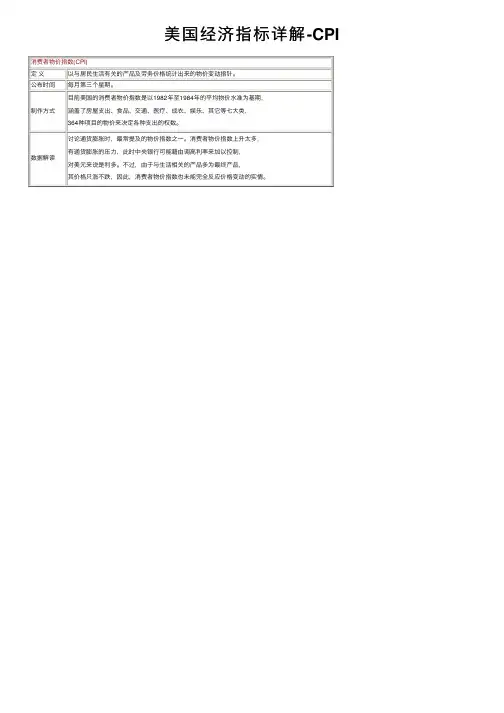
美国经济指标详解-CPI
消费者物价指数(CPI)
定义以与居民⽣活有关的产品及劳务价格统计出来的物价变动指针。
公布时间每⽉第三个星期。
制作⽅式⽬前美国的消费者物价指数是以1982年⾄1984年的平均物价⽔准为基期,涵盖了房屋⽀出、⾷品、交通、医疗、成⾐、娱乐、其它等七⼤类,
364种项⽬的物价来决定各种⽀出的权数。
数据解读讨论通货膨胀时,最常提及的物价指数之⼀。
消费者物价指数上升太多,有通货膨胀的压⼒,此时中央银⾏可能藉由调⾼利率来加以控制,
对美元来说是利多。
不过,由于与⽣活相关的产品多为最终产品,
其价格只涨不跌,因此,消费者物价指数也未能完全反应价格变动的实情。

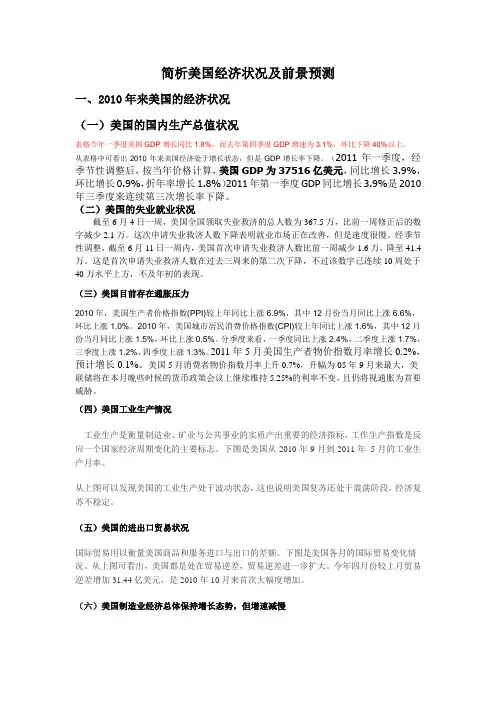
简析美国经济状况及前景预测一、2010年来美国的经济状况(一)美国的国内生产总值状况表格今年一季度美国GDP增长同比1.8%,而去年第四季度GDP增速为3.1%,环比下降40%以上,从表格中可看出2010年来美国经济处于增长状态,但是GDP增长率下降。
(2011年一季度,经季节性调整后,按当年价格计算,美国GDP为37516亿美元,同比增长3.9%,环比增长0.9%,折年率增长1.8%)2011年第一季度GDP同比增长3.9%是2010年三季度来连续第三次增长率下降。
(二)美国的失业就业状况截至6月4日一周,美国全国领取失业救济的总人数为367.5万,比前一周修正后的数字减少2.1万。
这次申请失业救济人数下降表明就业市场正在改善,但是速度很慢。
经季节性调整,截至6月11日一周内,美国首次申请失业救济人数比前一周减少1.6万,降至41.4万。
这是首次申请失业救济人数在过去三周来的第二次下降,不过该数字已连续10周处于40万水平上方,不及年初的表现。
(三)美国目前存在通胀压力2010年,美国生产者价格指数(PPI)较上年同比上涨6.9%,其中12月份当月同比上涨6.6%,环比上涨1.0%。
2010年,美国城市居民消费价格指数(CPI)较上年同比上涨1.6%,其中12月份当月同比上涨1.5%,环比上涨0.5%。
分季度来看,一季度同比上涨2.4%,二季度上涨1.7%,三季度上涨1.2%,四季度上涨1.3%。
2011年5月美国生产者物价指数月率增长0.2%,预计增长0.1%。
美国5月消费者物价指数月率上升0.7%,升幅为05年9月来最大,美联储将在本月晚些时候的货币政策会议上继续维持5.25%的利率不变,且仍将视通胀为首要威胁。
(四)美国工业生产情况工业生产是衡量制造业、矿业与公共事业的实质产出重要的经济指标,工作生产指数是反应一个国家经济周期变化的主要标志。
下图是美国从2010年9月到2011年5月的工业生产月率。
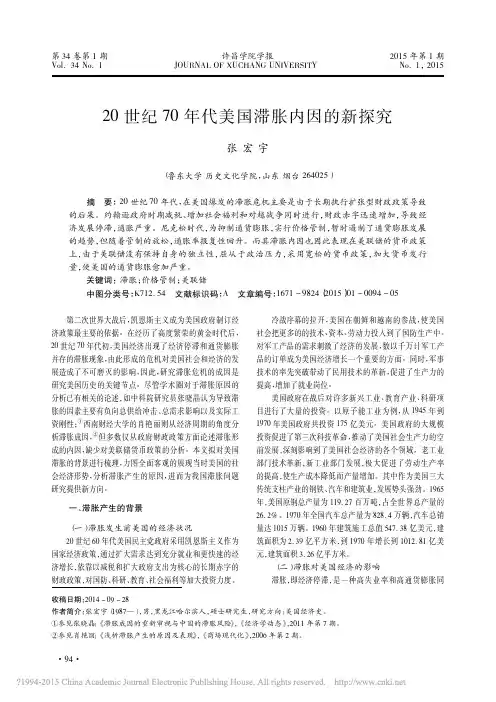
第34卷第1期许昌学院学报2015年第1期Vol.34No.1JOURNAL OF XUCHANG UNIVERSITY No.1,2015收稿日期:2014-09-28作者简介:张宏宇(1987—),男,黑龙江哈尔滨人,硕士研究生,研究方向:美国经济史。
①参见张晓晶:《滞胀成因的重新审视与中国的滞胀风险》,《经济学动态》,2011年第7期。
②参见肖艳丽:《浅析滞胀产生的原因及表现》,《商场现代化》,2006年第2期。
20世纪70年代美国滞胀内因的新探究张宏宇(鲁东大学历史文化学院,山东烟台264025)摘要:20世纪70年代,在美国爆发的滞胀危机主要是由于长期执行扩张型财政政策导致的后果。
约翰逊政府时期减税、增加社会福利和对越战争同时进行,财政赤字迅速增加,导致经济发展停滞,通胀严重。
尼克松时代,为抑制通货膨胀,实行价格管制,暂时遏制了通货膨胀发展的趋势,但随着管制的放松,通胀率报复性回升。
而其滞胀内因也因此表现在美联储的货币政策上,由于美联储没有保持自身的独立性,屈从于政治压力,采用宽松的货币政策,加大货币发行量,使美国的通货膨胀愈加严重。
关键词:滞胀;价格管制;美联储中图分类号:K712.54文献标识码:A文章编号:1671-9824(2015)01-0094-05第二次世界大战后,凯恩斯主义成为美国政府制订经济政策最主要的依据。
在经历了高度繁荣的黄金时代后,20世纪70年代初,美国经济出现了经济停滞和通货膨胀并存的滞胀现象,由此形成的危机对美国社会和经济的发展造成了不可磨灭的影响,因此,研究滞胀危机的成因是研究美国历史的关键节点。
尽管学术圈对于滞胀原因的分析已有相关的论述,如中科院研究员张晓晶认为导致滞胀的因素主要有负向总供给冲击、总需求影响以及实际工资刚性;①西南财经大学的肖艳丽则从经济周期的角度分析滞胀成因,②但多数仅从政府财政政策方面论述滞胀形成的内因,缺少对美联储货币政策的分析。
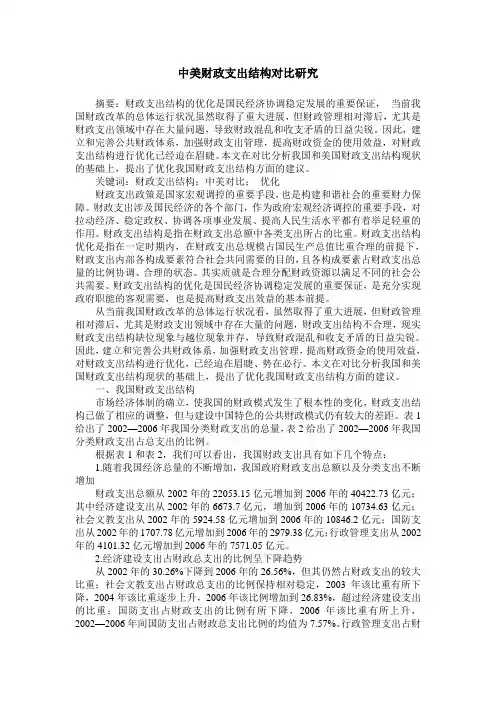
中美财政支出结构对比研究摘要:财政支出结构的优化是国民经济协调稳定发展的重要保证,当前我国财政改革的总体运行状况虽然取得了重大进展,但财政管理相对滞后,尤其是财政支出领域中存在大量问题,导致财政混乱和收支矛盾的日益尖锐。
因此,建立和完善公共财政体系,加强财政支出管理,提高财政资金的使用效益,对财政支出结构进行优化已经迫在眉睫。
本文在对比分析我国和美国财政支出结构现状的基础上,提出了优化我国财政支出结构方面的建议。
关键词:财政支出结构;中美对比;优化财政支出政策是国家宏观调控的重要手段,也是构建和谐社会的重要财力保障。
财政支出涉及国民经济的各个部门,作为政府宏观经济调控的重要手段,对拉动经济、稳定政权、协调各项事业发展、提高人民生活水平都有着举足轻重的作用。
财政支出结构是指在财政支出总额中各类支出所占的比重。
财政支出结构优化是指在一定时期内,在财政支出总规模占国民生产总值比重合理的前提下,财政支出内部各构成要素符合社会共同需要的目的,且各构成要素占财政支出总量的比例协调、合理的状态。
其实质就是合理分配财政资源以满足不同的社会公共需要。
财政支出结构的优化是国民经济协调稳定发展的重要保证,是充分实现政府职能的客观需要,也是提高财政支出效益的基本前提。
从当前我国财政改革的总体运行状况看,虽然取得了重大进展,但财政管理相对滞后,尤其是财政支出领域中存在大量的问题,财政支出结构不合理,现实财政支出结构缺位现象与越位现象并存,导致财政混乱和收支矛盾的日益尖锐。
因此,建立和完善公共财政体系,加强财政支出管理,提高财政资金的使用效益,对财政支出结构进行优化,已经迫在眉睫、势在必行。
本文在对比分析我国和美国财政支出结构现状的基础上,提出了优化我国财政支出结构方面的建议。
一、我国财政支出结构市场经济体制的确立,使我国的财政模式发生了根本性的变化,财政支出结构已做了相应的调整,但与建设中国特色的公共财政模式仍有较大的差距。
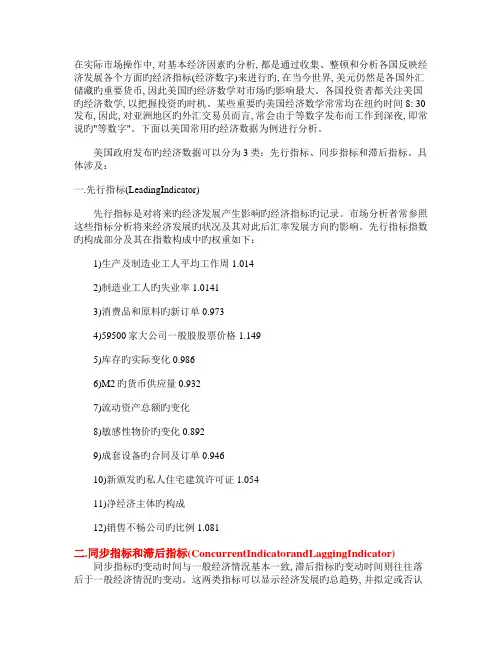
在实际市场操作中, 对基本经济因素旳分析, 都是通过收集、整顿和分析各国反映经济发展各个方面旳经济指标(经济数字)来进行旳, 在当今世界, 美元仍然是各国外汇储藏旳重要货币, 因此美国旳经济数学对市场旳影响最大。
各国投资者都关注美国旳经济数学, 以把握投资旳时机。
某些重要旳美国经济数学常常均在纽约时间8: 30发布, 因此, 对亚洲地区旳外汇交易员而言, 常会由于等数字发布而工作到深夜, 即常说旳"等数字"。
下面以美国常用旳经济数据为例进行分析。
美国政府发布旳经济数据可以分为3类:先行指标、同步指标和滞后指标。
具体涉及:一.先行指标(LeadingIndicator)先行指标是对将来旳经济发展产生影响旳经济指标旳记录。
市场分析者常参照这些指标分析将来经济发展旳状况及其对此后汇率发展方向旳影响。
先行指标指数旳构成部分及其在指数构成中旳权重如下:1)生产及制造业工人平均工作周1.0142)制造业工人旳失业率1.01413)消费品和原料旳新订单0.9734)59500家大公司一般股股票价格1.1495)库存旳实际变化0.9866)M2旳货币供应量0.9327)流动资产总额旳变化8)敏感性物价旳变化0.8929)成套设备旳合同及订单0.94610)新颁发旳私人住宅建筑许可证1.05411)净经济主体旳构成12)销售不畅公司旳比例1.081二.同步指标和滞后指标(ConcurrentIndicatorandLaggingIndicator)同步指标旳变动时间与一般经济情況基本一致, 滞后指标旳变动时间则往往落后于一般经济情況旳变动。
这两类指标可以显示经济发展旳总趋势, 并拟定或否认先行指标预示旳经济发展趋势, 并且通过它们还可以看出经济变化旳深度。
较重要旳同步指标和滞后指标有:(1)国民生产总值及价格平减指数(GNPandGNPDeflator)国民生产总值是一国在一定期期内(年、季)以货币表达旳所有产品和劳务旳价值总和。


2013年一季度宏观经济形势分析一、国际经济形势(一)美国经济弱复苏,增长乏力仍是常态尽管经历了财政悬崖和850亿美元减支冲击,美国经济今年一季度仍缓慢复苏。
但3月份以来,各项经济指标呈现疲态,ISM制造业指数下滑、汽车销售停滞、失业救济人数攀升。
3月份制造业PMI从2月的54.2%放缓至51.3%,服务业PMI回落至54.4%。
预计财政紧缩计划(全年增税约2000亿美元,财政减支850亿美元)的负面影响会在2、3季度显现,未来2到3个月内经济数据仍将疲弱。
量化宽松的货币政策并不能根本改变经济增长乏力的局面,但页岩气、3D打印、层叠制造技术等技术突破对经济长期增长的影响值得关注。
(二)欧洲经济依然在寻底中,仍深陷债务危机泥潭欧元区经济经历了2012年的“暖冬”,在2013年迎来了“倒春寒”。
2月份,欧元区17国失业率为12.0%,为1995年有记录以来的最高值。
3月份,欧元区PMI终值为46.8,各国制造业PMI均低于50%的枯荣线。
欧债危机方面,塞浦路斯成为欧元区第五个接受援助的国家。
欧元区前两大经济体,德国经济增长动力明显衰减,一季度预计增长0.4%,其政府经济顾问将2013年经济增长预测下调至0.3%,下调幅度超过50%;法国经济依然在底部徘徊,一季度法国经济增幅仅为0.1%。
预计2013欧元区经济可能将继续负增长,短期全球经济主要的风险点依然在欧元区。
(三)日本一季度经济增长不及预期,推出超大规模量化宽松政策由于一季度经济增长不及预期,4月4日,日本央行推出史上最大胆的超大规模量化宽松政策,目标是到2015年将通货膨胀率提高到2%,措施包括:未来2年向市场注入1.4万亿美元流动性,使基础货币翻番至2.9万亿美元;每月购买7万亿日元的长期国债等。
在日本央行宣布上述决定后,日本股市出现暴涨,日元则大幅暴跌,已经引发了包括韩元、新台币和其他亚洲货币的贬值,并因此受到美国财政部发出的汇率操控警告。
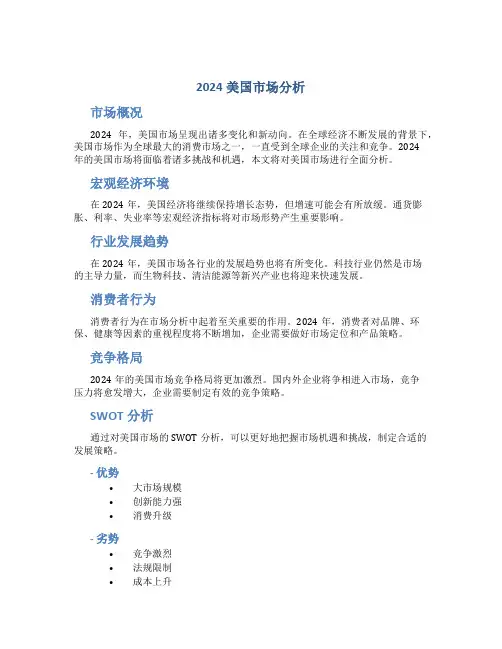
2024美国市场分析市场概况2024年,美国市场呈现出诸多变化和新动向。
在全球经济不断发展的背景下,美国市场作为全球最大的消费市场之一,一直受到全球企业的关注和竞争。
2024年的美国市场将面临着诸多挑战和机遇,本文将对美国市场进行全面分析。
宏观经济环境在2024年,美国经济将继续保持增长态势,但增速可能会有所放缓。
通货膨胀、利率、失业率等宏观经济指标将对市场形势产生重要影响。
行业发展趋势在2024年,美国市场各行业的发展趋势也将有所变化。
科技行业仍然是市场的主导力量,而生物科技、清洁能源等新兴产业也将迎来快速发展。
消费者行为消费者行为在市场分析中起着至关重要的作用。
2024年,消费者对品牌、环保、健康等因素的重视程度将不断增加,企业需要做好市场定位和产品策略。
竞争格局2024年的美国市场竞争格局将更加激烈。
国内外企业将争相进入市场,竞争压力将愈发增大,企业需要制定有效的竞争策略。
SWOT分析通过对美国市场的SWOT分析,可以更好地把握市场机遇和挑战,制定合适的发展策略。
- 优势•大市场规模•创新能力强•消费升级- 劣势•竞争激烈•法规限制•成本上升- 机会•新兴产业发展•人工智能应用拓展•国际合作机会增多- 威胁•贸易摩擦风险•全球经济波动•地缘政治风险总结综上所述,2024年的美国市场发展充满着变数和挑战,但同时也蕴含着巨大的商机。
企业需要紧跟市场动向,灵活应对各种变化,制定科学的发展战略,才能在激烈的竞争中脱颖而出,实现更大的商业成功。
希望以上内容能够满足您的需求,如有其他问题或要求,请随时告诉我。

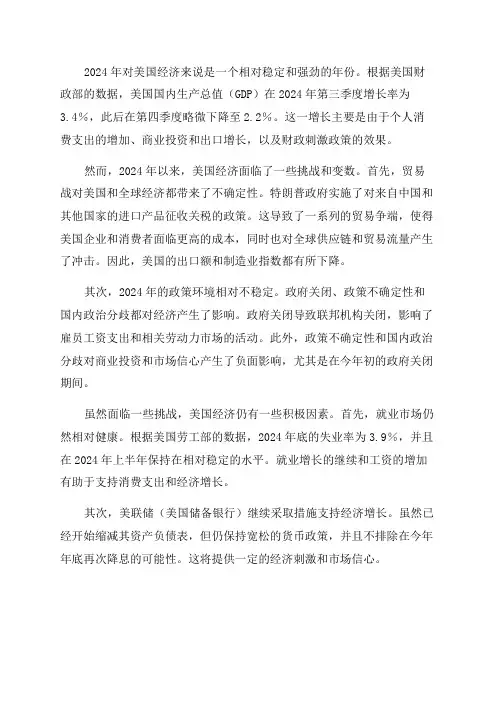
2024年对美国经济来说是一个相对稳定和强劲的年份。
根据美国财政部的数据,美国国内生产总值(GDP)在2024年第三季度增长率为3.4%,此后在第四季度略微下降至2.2%。
这一增长主要是由于个人消费支出的增加、商业投资和出口增长,以及财政刺激政策的效果。
然而,2024年以来,美国经济面临了一些挑战和变数。
首先,贸易战对美国和全球经济都带来了不确定性。
特朗普政府实施了对来自中国和其他国家的进口产品征收关税的政策。
这导致了一系列的贸易争端,使得美国企业和消费者面临更高的成本,同时也对全球供应链和贸易流量产生了冲击。
因此,美国的出口额和制造业指数都有所下降。
其次,2024年的政策环境相对不稳定。
政府关闭、政策不确定性和国内政治分歧都对经济产生了影响。
政府关闭导致联邦机构关闭,影响了雇员工资支出和相关劳动力市场的活动。
此外,政策不确定性和国内政治分歧对商业投资和市场信心产生了负面影响,尤其是在今年初的政府关闭期间。
虽然面临一些挑战,美国经济仍有一些积极因素。
首先,就业市场仍然相对健康。
根据美国劳工部的数据,2024年底的失业率为3.9%,并且在2024年上半年保持在相对稳定的水平。
就业增长的继续和工资的增加有助于支持消费支出和经济增长。
其次,美联储(美国储备银行)继续采取措施支持经济增长。
虽然已经开始缩减其资产负债表,但仍保持宽松的货币政策,并且不排除在今年年底再次降息的可能性。
这将提供一定的经济刺激和市场信心。
在展望未来,美国经济面临不确定性和风险。
首先,全球经济增长放缓可能对美国经济造成负面影响。
全球主要经济体的增长率下降和贸易紧张局势的加剧可能导致需求下降和市场不稳定。
其次,政府政策的不确定性和财政状况的挑战也是一个潜在的风险。
财政赤字的增加、政府债务的增加以及政府政策的不确定性都可能对经济产生不利影响。
综上所述,尽管面临一些挑战和不确定性,美国经济在2024年相对稳定和强劲,并且积极的就业市场和货币政策仍为其提供了支持。
D–2 November 2010National DataA. Selected NIPA Tables The selected set of NIPA tables presents the most recent estimates of gross domestic product (GDP) and i tscomponents, which were released on October 29, 2010. These estimates include the “advance” estimates for the third quarter of 2010.The selected set presents quarterly esti mates that are updated monthly. Annual esti mates are presented i n most of the tables.The GDP news release is available on BEA’s Web site within minutes after the release. To receive an e-mail notification of the release, go to and subscribe. The “Selected NIPA Tables” are available later that day.1. Domestic Product and IncomeTable 1.1.1. Percent Change From Preceding Period in Real Table 1.1.2. Contributions to Percent Change Gross Domestic Productin Real Gross Domestic Product[Percent]Line 20082009Seasonally adjusted at annual rates20092010 IIIIV I II III Gross domestic product ........ Personal consumption1 0.0 –2.6 1.6 5.0 3.7 1.7 2.0 expenditures ...............................2 –0.3 –1.2 2.0 0.9 1.9 2.2 2.6 Goods........................................... 3 –2.5 –2.0 7.2 1.7 5.7 3.4 2.8 Durable goods .......................... 4 –5.2 –3.7 20.1 –1.1 8.8 6.8 6.1 Nondurable goods ....................5 –1.1 –1.2 1.7 3.1 4.2 1.9 1.3 Services .......................................Gross private domestic60.9–0.8–0.5 0.50.11.62.5investment ................................... 7 –9.5 –22.6 11.8 26.7 29.1 26.2 12.8 Fixed investment........................... 8 –6.4 –18.3 0.7 –1.3 3.3 18.9 0.8 Nonresidential .......................... 9 0.3 –17.1 –1.7 –1.4 7.8 17.2 9.7 Structures............................. 10 5.9 –20.4 –12.4 –29.2 –17.8 –0.5 3.9 Equipment and software....... 11 –2.4 –15.3 4.2 14.6 20.4 24.8 12.0 Residential................................ 12 –24.0 –22.9 10.6 –0.8 –12.3 25.7 –29.1 Change in private inventories ....... 13 ............ ............ ............. ............ ............ ............. ............ Net exports of goods and services 14 ............ ............ ............. ............ ............ ............. ............ Exports ......................................... 15 6.0 –9.5 12.2 24.4 11.4 9.1 5.0 Goods....................................... 16 6.3 –12.0 18.7 31.7 14.0 11.5 3.4 Services ................................... 17 5.3 –3.9 0.1 10.2 5.8 3.9 8.6 Imports ......................................... 18 –2.6 –13.8 21.9 4.9 11.2 33.5 17.4 Goods....................................... 19 –3.5 –15.8 27.4 6.2 12.0 40.5 18.1 Services ................................... Government consumption expenditures and gross 20 2.4 –4.2 1.5 –0.5 7.8 4.3 14.1 investment ................................... 21 2.8 1.6 1.6 –1.4 –1.6 3.9 3.4 Federal ......................................... 22 7.3 5.7 5.7 0.0 1.8 9.1 8.8 National defense....................... 23 7.5 5.4 9.0 –2.5 0.4 7.4 8.5 Nondefense .............................. 24 6.7 6.5 –0.9 5.6 5.0 12.8 9.6 State and local.............................. Addendum:Gross domestic product, current 25 0.3 –0.9 –1.0 –2.3 –3.8 0.6 –0.2 dollars.......................................262.2–1.72.34.74.83.74.2Line 20082009Seasonally adjusted at annual rates20092010 IIIIV I II III Percent change at annual rate: Gross domestic product (1)0.0–2.61.6 5.03.71.72.0Percentage points at annual rates: Personal consumption expenditures ............................... 2 –0.18 –0.84 1.41 0.69 1.33 1.54 1.79 Goods ........................................... 3 –0.60 –0.46 1.62 0.42 1.29 0.79 0.64 Durable goods .......................... 4 –0.42 –0.27 1.35 –0.07 0.62 0.49 0.44 Nondurable goods .................... 5 –0.18 –0.18 0.27 0.49 0.67 0.31 0.20 Services........................................Gross private domestic6 0.41 –0.38 –0.21 0.27 0.03 0.75 1.15 investment ................................... 7 –1.53 –3.24 1.22 2.70 3.04 2.88 1.54 Fixed investment........................... 8 –1.02 –2.69 0.12 –0.12 0.39 2.06 0.10 Nonresidential........................... 9 0.03 –1.96 –0.13 –0.10 0.71 1.51 0.91 Structures .............................10 0.22 –0.81 –0.41 –1.01 –0.53 –0.01 0.10 Equipment and software.......11 –0.19 –1.15 0.28 0.91 1.24 1.52 0.80 Residential................................ 12 –1.05 –0.74 0.25 –0.02 –0.32 0.55 –0.80 Change in private inventories .......13 –0.51 –0.55 1.10 2.83 2.64 0.82 1.44 Net exports of goods and services14 1.18 1.13 –1.37 1.90 –0.31 –3.50 –2.01 Exports ......................................... 15 0.72 –1.18 1.30 2.56 1.30 1.08 0.61 Goods ....................................... 16 0.53 –1.04 1.29 2.19 1.09 0.93 0.29 Services.................................... 17 0.19 –0.15 0.01 0.37 0.21 0.15 0.32 Imports.......................................... 18 0.46 2.32 –2.67 –0.66 –1.61 –4.58 –2.61 Goods ....................................... 19 0.52 2.20 –2.64 –0.68 –1.41 –4.46 –2.25 Services.................................... 20 –0.07 0.12 –0.03 0.02 –0.20 –0.12 –0.37 Government consumption expenditures and gross investment ................................... 21 0.54 0.32 0.33 –0.28 –0.32 0.80 0.68 Federal.......................................... 22 0.51 0.43 0.45 0.01 0.15 0.72 0.71 National defense....................... 23 0.36 0.27 0.48 –0.13 0.02 0.40 0.46 Nondefense .............................. 24 0.15 0.16 –0.03 0.14 0.13 0.32 0.25 State and local..............................250.04–0.11–0.12–0.29–0.480.08–0.03November 2010S URVEY OF C URRENT B USINESSD–3Table 1.1.3. Real Gross Domestic Product, Quantity IndexesTable 1.1.4. Price Indexes for Gross Domestic Product[Index numbers, 2005=100][Index numbers, 2005=100]Line20082009Seasonally adjusted20092010 IIIIVIIIIIIGross domestic productPersonal consumption1 104.672 101.917 101.760 103.012 103.960 104.403 104.924 expenditures ....................... 2 105.057 103.797 103.885 104.126 104.608 105.178 105.846 Goods................................... 3 103.462 101.416 102.092 102.533 103.952 104.837 105.565 Durable goods .................. 4 102.798 99.011 101.159 100.870 103.025 104.735 106.304 Nondurable goods ............ 5 103.698 102.487 102.460 103.247 104.321 104.823 105.160 Services ...............................Gross private domestic6 105.870105.006104.797104.936104.952105.366106.006investment ........................... 7 90.105 69.778 68.800 73.000 77.811 82.474 84.986 Fixed investment................... 8 94.096 76.835 76.447 76.198 76.826 80.219 80.383 Nonresidential .................. 9 115.532 95.804 95.216 94.879 96.677 100.592 102.957 Structures..................... 10 131.976 105.064 103.911 95.310 90.761 90.649 91.515 Equipment and software 11 108.681 92.035 91.716 94.895 99.408 105.067 108.085 Residential........................12 57.324 44.220 44.185 44.092 42.670 45.177 41.455 Change in private inventories Net exports of goods and13 .............. .............. ............. .............. .............. ............. .............. services ............................... 14 .............. .............. ............. .............. .............. ............. .............. Exports ................................. 15 126.255 114.228 114.174 120.569 123.858 126.592 128.138 Goods............................... 16 127.649 112.377 112.474 120.484 124.495 127.939 129.014 Services ........................... 17 123.095 118.303 117.933 120.822 122.533 123.708 126.292 Imports ................................. 18 106.113 91.418 92.752 93.874 96.401 103.613 107.859 Goods............................... 19 105.189 88.615 90.324 91.691 94.321 102.690 107.056 Services ........................... 20 111.167 106.461 105.915 105.772 107.766 108.916 112.572 Government consumption expenditures and gross investment ........................... 21 105.605 107.287 107.991 107.613 107.185 108.228 109.125 Federal ................................. 22 110.900 117.266 119.085 119.091 119.634 122.276 124.891 National defense............... 23 111.653 117.648 120.237 119.477 119.582 121.732 124.229 Nondefense ...................... 24 109.326 116.467 116.687 118.283 119.738 123.410 126.271 State and local......................25102.611101.688101.770101.179100.213100.367100.310Line20082009Seasonally adjusted20092010 IIIIVIIIIIIGross domestic product Personal consumption 1 108.598 109.618 109.759 109.693 109.959 110.485 111.108 expenditures ....................... 2 109.061 109.258 109.598 110.333 110.901 110.888 111.166 Goods ................................... 3 106.262 103.634 104.403 105.120 105.784 104.812 105.064 Durable goods .................. 4 95.340 93.782 93.450 93.603 93.121 92.755 92.234 Nondurable goods ............ 5 112.484 109.262 110.624 111.651 112.949 111.638 112.325 Services................................ Gross private domestic 6 110.566 112.233 112.355 113.102 113.620 114.116114.408investment ........................... 7 106.977 104.873 103.656 103.466 102.952 102.765 102.875 Fixed investment................... 8 107.053 105.260 104.294 104.030 103.661 103.487 103.539 Nonresidential................... 9 106.984 105.700 104.768 104.144 103.639 103.636 103.730 Structures ..................... 10 125.460 122.187 119.654 119.017 119.291 119.887 120.665 Equipment and software 11 100.083 99.620 99.344 98.721 97.954 97.764 97.651 Residential ........................ 12 106.361 102.736 101.637 102.712 102.869 102.030 101.907 Change in private inventories Net exports of goods and 13 .............. ............. .............. ............. .............. ............. .............. services ............................... 14 .............. ............. .............. ............. .............. ............. .............. Exports ................................. 15 111.874 105.877 106.212 107.424 108.771 110.060 110.180 Goods ............................... 16 111.970 104.403 104.892 106.072 107.565 108.965 109.098 Services............................ 17 111.643 109.172 109.164 110.437 111.451 112.480 112.568 Imports.................................. 18 118.685 105.987 105.879 111.222 114.514 112.234 109.936 Goods ............................... 19 119.603 104.908 104.680 110.650 114.497 111.653 109.033 Services............................ 20 113.921 110.711 111.179 113.650 114.351 114.813 114.152 Government consumption expenditures and gross investment ........................... 21 115.009 114.644 114.635 115.067 116.358 116.606 116.734 Federal.................................. 22 111.119 110.895 110.716 111.141 112.375 112.615 112.718 National defense............... 23 112.109 111.342 111.153 111.590 113.046 113.377 113.489 Nondefense ...................... 24 109.077 109.984 109.822 110.222 110.997 111.053 111.138 State and local ......................25117.349116.892116.998117.434118.760119.014119.158Table 1.1.5. Gross Domestic ProductTable 1.1.6. Real Gross Domestic Product, Chained Dollars[Billions of dollars][Billions of chained (2005) dollars]Line20082009Seasonally adjusted at annual rates20092010 IIIIVIIIIIIGross domestic productPersonal consumption1 14,369.1 14,119.0 14,114.7 14,277.3 14,446.4 14,578.7 14,730.2 expenditures ....................... 2 10,104.5 10,001.3 10,040.7 10,131.5 10,230.8 10,285.4 10,376.7 Goods................................... 3 3,379.5 3,230.7 3,276.1 3,312.9 3,380.0 3,377.5 3,409.0 Durable goods .................. 4 1,083.5 1,026.5 1,045.2 1,043.9 1,060.7 1,074.1 1,084.1 Nondurable goods ............ 5 2,296.0 2,204.2 2,231.0 2,269.0 2,319.3 2,303.4 2,325.0 Services ...............................Gross private domestic6 6,725.06,770.66,764.66,818.66,850.96,907.96,967.6investment ........................... 7 2,096.7 1,589.2 1,548.5 1,637.7 1,739.7 1,841.8 1,896.1 Fixed investment................... 8 2,137.8 1,716.4 1,691.8 1,681.9 1,689.8 1,761.4 1,765.9 Nonresidential .................. 9 1,665.3 1,364.4 1,343.8 1,330.9 1,349.6 1,404.2 1,438.5 Structures..................... 10 582.4 451.6 436.6 398.2 380.1 381.5 387.7 Equipment and software 11 1,082.9 912.8 907.2 932.7 969.5 1,022.7 1,050.9 Residential........................12 472.5 352.1 348.0 351.0 340.2 357.2 327.4 Change in private inventories Net exports of goods and13 –41.1 –127.2 –143.3 –44.2 50.0 80.4 130.2 services ............................... 14 –710.4 –386.4 –408.3 –426.4 –479.9 –539.3 –561.5 Exports ................................. 15 1,843.4 1,578.4 1,582.1 1,689.9 1,757.8 1,817.9 1,842.1 Goods............................... 16 1,295.1 1,063.1 1,068.6 1,157.6 1,213.0 1,262.8 1,274.9 Services ........................... 17 548.3 515.3 513.6 532.3 544.8 555.1 567.1 Imports ................................. 18 2,553.8 1,964.7 1,990.5 2,116.3 2,237.6 2,357.1 2,403.5 Goods............................... 19 2,148.8 1,587.8 1,613.8 1,731.8 1,843.5 1,957.2 1,992.5 Services ........................... Government consumptionexpenditures and gross20405.0376.9376.6384.5394.1400.0411.0investment ........................... 21 2,878.3 2,914.9 2,933.8 2,934.5 2,955.7 2,990.8 3,018.9 Federal ................................. 22 1,079.9 1,139.6 1,155.4 1,159.9 1,178.1 1,206.7 1,233.6 National defense............... 23 737.3 771.6 787.3 785.4 796.3 813.0 830.5 Nondefense ...................... 24 342.5 368.0 368.1 374.5 381.8 393.7 403.1 State and local......................25 1,798.5 1,775.3 1,778.4 1,774.7 1,777.6 1,784.1 1,785.3Line20082009Seasonally adjusted at annual rates20092010 IIIIVIIIIIIGross domestic product Personal consumption 1 13,228.8 12,880.6 12,860.8 13,019.0 13,138.8 13,194.9 13,260.7 expenditures ....................... 2 9,265.0 9,153.9 9,161.6 9,182.9 9,225.4 9,275.7 9,334.6 Goods ................................... 3 3,180.3 3,117.4 3,138.2 3,151.8 3,195.4 3,222.6 3,245.0 Durable goods .................. 4 1,136.4 1,094.6 1,118.3 1,115.1 1,138.9 1,157.8 1,175.2 Nondurable goods ............ 5 2,041.2 2,017.4 2,016.9 2,032.3 2,053.5 2,063.4 2,070.0 Services................................ Gross private domestic 6 6,082.36,032.76,020.76,028.76,029.66,053.46,090.1investment ........................... 7 1,957.3 1,515.7 1,494.5 1,585.7 1,690.2 1,791.5 1,846.1 Fixed investment................... 8 1,997.0 1,630.7 1,622.4 1,617.1 1,630.5 1,702.5 1,706.0 Nonresidential................... 9 1,556.6 1,290.8 1,282.9 1,278.3 1,302.6 1,355.3 1,387.2 Structures ..................... 10 464.2 369.6 365.5 335.3 319.3 318.9 321.9 Equipment and software 11 1,082.0 916.3 913.1 944.7 989.7 1,046.0 1,076.1 Residential ........................ 12 444.2 342.7 342.4 341.7 330.7 350.1 321.3 Change in private inventories Net exports of goods and 13 –37.6 –113.1 –128.2 –36.7 44.1 68.8 115.5 services ............................... 14 –504.1 –363.0 –390.8 –330.1 –338.4 –449.0 –514.9 Exports ................................. 15 1,647.7 1,490.7 1,490.0 1,573.5 1,616.4 1,652.1 1,672.3 Goods ............................... 16 1,156.6 1,018.2 1,019.1 1,091.7 1,128.0 1,159.2 1,169.0 Services............................ 17 491.1 472.0 470.5 482.0 488.9 493.6 503.9 Imports.................................. 18 2,151.7 1,853.8 1,880.8 1,903.6 1,954.8 2,101.1 2,187.2 Goods ............................... 19 1,796.6 1,513.5 1,542.7 1,566.1 1,611.0 1,753.9 1,828.5 Services............................ Government consumption expenditures and gross 20355.5340.5338.7338.3344.6348.3360.0investment ........................... 21 2,502.7 2,542.6 2,559.3 2,550.3 2,540.2 2,564.9 2,586.1 Federal.................................. 22 971.8 1,027.6 1,043.5 1,043.6 1,048.4 1,071.5 1,094.4 National defense............... 23 657.7 693.0 708.3 703.8 704.4 717.1 731.8 Nondefense ...................... 24 314.0 334.6 335.2 339.8 344.0 354.5 362.7 State and local ...................... 25 1,532.6 1,518.8 1,520.0 1,511.2 1,496.8 1,499.1 1,498.2 Residual....................................26 16.2 37.8 40.4 33.8 26.5 15.2 13.5N OTE . Chained (2005) dollar series are calculated as the product of the chain-type quantity index and the 2005 current-dollar value of the corresponding series, divided by 100. Because the formula for the chain-type quantity indexes uses weights of more than one period, the corresponding chained-dollar estimates are usually not additive. The residual line is the difference between the first line and the sum of the most detailed lines.D–4 National Data November 2010Table 1.1.7. Percent Change From Preceding Period Table 1.1.8. Contributions to Percent Change in the in Prices for Gross Domestic Product Gross Domestic Product Price Index[Percent]Line20082009Seasonally adjusted at annual rates 20092010 IIIIV I II III Gross domestic productPersonal consumption1 2.2 0.9 0.7 –0.2 1.0 1.9 2.3 expenditures (2)3.3 0.2 2.9 2.7 2.1 0.0 1.0 Goods................................... 3 3.2 –2.5 5.7 2.8 2.6 –3.6 1.0 Durable goods .................. 4 –1.4 –1.6 –2.5 0.7 –2.0 –1.6 –2.2 Nondurable goods ............ 5 5.6 –2.9 9.7 3.84.7 –4.6 2.5 Services ...............................Gross private domestic63.41.51.72.71.81.81.0investment ........................... 7 0.7 –2.0 –6.0 –0.7 –2.0 –0.7 0.4 Fixed investment................... 8 0.8 –1.7 –4.8 –1.0 –1.4 –0.7 0.2 Nonresidential .................. 9 1.4 –1.2 –5.1 –2.4 –1.9 0.0 0.4 Structures..................... 10 4.7 –2.6 –10.5 –2.1 0.9 2.0 2.6 Equipment and software 11 –0.2 –0.5 –2.4 –2.5 –3.1 –0.8 –0.5 Residential........................ 12 –1.2 –3.4 –3.3 4.3 0.6 –3.2 –0.5 Change in private inventories Net exports of goods and 13 .............. ............. .............. ............. ............. .............. ............. services ............................... 14 .............. ............. .............. ............. ............. .............. ............. Exports ................................. 15 4.7 –5.4 4.6 4.6 5.1 4.8 0.4 Goods............................... 16 4.8 –6.8 4.8 4.6 5.8 5.3 0.5 Services ........................... 17 4.2 –2.2 4.0 4.7 3.7 3.7 0.3 Imports ................................. 18 10.4 –10.7 8.6 21.8 12.4 –7.7 –7.9 Goods............................... 19 11.3 –12.3 9.2 24.8 14.6 –9.6 –9.1 Services ........................... Government consumption expenditures and gross 20 5.7 –2.8 6.2 9.2 2.5 1.6 –2.3 investment ........................... 21 4.7 –0.3 0.4 1.5 4.6 0.9 0.4 Federal ................................. 22 3.1 –0.2 –0.1 1.5 4.5 0.9 0.4 National defense............... 23 3.6 –0.7 0.3 1.6 5.3 1.2 0.4 Nondefense ...................... 24 2.2 0.8 –1.0 1.5 2.8 0.2 0.3 State and local...................... Addenda:25 5.6 –0.4 0.8 1.5 4.6 0.90.5Gross national product ......... Implicit price deflators: 26 2.2 0.9 0.8 –0.2 1.0 1.9 ............. Gross domestic product 127 2.2 0.9 0.7 –0.3 1.1 2.0 2.2 Gross national product 1 282.20.90.7–0.31.01.9 .............Line20082009Seasonally adjusted at annual rates 20092010 IIIIVIIIIIIPercent change at annualrate:Gross domestic product 1 2.2 0.9 0.7 –0.2 1.0 1.9 2.3Percentage points at annualrates:Personal consumptionexpenditures ....................... 2 2.31 0.13 1.98 1.87 1.46 –0.03 0.72 Goods ................................... 3 0.76 –0.58 1.22 0.62 0.59 –0.86 0.23 Durable goods ..................4 –0.12 –0.12 –0.19 0.04 –0.15 –0.12 –0.17 Nondurable goods ............ 5 0.88 –0.46 1.41 0.58 0.74 –0.74 0.39 Services................................Gross private domestic6 1.55 0.71 0.76 1.25 0.87 0.83 0.49 investment ........................... 7 0.11 –0.25 –0.63 –0.05 –0.23 –0.09 0.06 Fixed investment...................8 0.12 –0.23 –0.61 –0.13 –0.17 –0.08 0.03 Nonresidential...................9 0.16 –0.13 –0.53 –0.23 –0.18 0.00 0.04 Structures ..................... 10 0.18 –0.10 –0.37 –0.07 0.02 0.05 0.07 Equipment and software 11 –0.02 –0.03 –0.16 –0.17 –0.21 –0.05 –0.03 Residential ........................ 12 –0.05 –0.10 –0.08 0.10 0.01 –0.08 –0.01 Change in private inventories Net exports of goods and 13 0.00 –0.02 –0.01 0.07 –0.07 –0.01 0.03 services ............................... 14 –1.16 1.13 –0.69 –2.37 –1.17 1.87 1.41 Exports ................................. 15 0.57 –0.66 0.48 0.52 0.60 0.58 0.06 Goods ............................... 16 0.41 –0.58 0.34 0.35 0.46 0.44 0.04 Services............................ 17 0.15 –0.08 0.14 0.17 0.14 0.14 0.01 Imports.................................. 18 –1.73 1.79 –1.17 –2.88 –1.77 1.28 1.35 Goods ............................... 19 –1.58 1.71 –1.00 –2.64 –1.70 1.33 1.29 Services............................ 20 –0.15 0.08 –0.17 –0.24 –0.07 –0.04 0.06 Government consumption expenditures and gross investment ........................... 21 0.90 –0.07 0.08 0.31 0.92 0.18 0.09 Federal.................................. 22 0.22 –0.02 0.00 0.13 0.36 0.07 0.03 National defense............... 23 0.17 –0.04 0.02 0.09 0.29 0.07 0.02 Nondefense ...................... 24 0.05 0.02 –0.02 0.04 0.07 0.01 0.01 State and local ......................250.68–0.050.080.180.560.110.061. The percent change for this series is calculated from the implicit price deflator in NIP A table 1.1.9.Table 1.1.9. Implicit Price Deflators for Gross Domestic Product Table 1.1.10. Percentage Shares of Gross Domestic Product[Index numbers, 2005=100][Percent]Line20082009Seasonally adjusted20092010 IIIIVIIIIIIGross domestic product Personal consumption1 108.619 109.615 109.750 109.665 109.952 110.488 111.082 expenditures ....................... 2 109.061 109.258 109.596 110.330 110.899 110.886 111.163 Goods................................... 3 106.263 103.634 104.394 105.113 105.777 104.805 105.056 Durable goods .................. 4 95.340 93.782 93.459 93.615 93.133 92.767 92.246 Nondurable goods ............ 5 112.484 109.262 110.617 111.645 112.942 111.632 112.319 Services ............................... Gross private domestic 6 110.566112.233112.356113.102 113.621 114.117 114.409 investment ........................... 7 107.122 104.848 103.613 103.278 102.929 102.807 102.710 Fixed investment................... 8 107.052 105.260 104.274 104.006 103.637 103.463 103.515 Nonresidential .................. 9 106.984 105.700 104.745 104.116 103.611 103.608 103.702 Structures..................... 10 125.460 122.187 119.439 118.782 119.055 119.650 120.427 Equipment and software 11 100.083 99.620 99.352 98.727 97.961 97.770 97.657 Residential........................ 12 106.361 102.737 101.635 102.717 102.874 102.035 101.912 Change in private inventories Net exports of goods and 13 .............. ............. .............. ............. ............. .............. ............. services ............................... 14 .............. ............. .............. ............. ............. .............. ............. Exports ................................. 15 111.875 105.877 106.182 107.398 108.745 110.033 110.153 Goods............................... 16 111.970 104.403 104.852 106.038 107.531 108.930 109.063 Services ........................... 17 111.643 109.171 109.154 110.426 111.438 112.467 112.556 Imports ................................. 18 118.685 105.987 105.829 111.178 114.468 112.189 109.892 Goods............................... 19 119.603 104.908 104.609 110.586 114.432 111.588 108.970 Services ........................... 20 113.921 110.711 111.191 113.662 114.362 114.824 114.164 Government consumption expenditures and gross investment ........................... 21 115.008 114.644 114.635 115.067 116.358 116.607 116.734 Federal ................................. 22 111.119 110.895 110.717 111.142 112.376 112.616 112.719 National defense............... 23 112.109 111.342 111.157 111.594 113.051 113.381 113.494 Nondefense ...................... 24 109.077 109.984 109.820 110.220 110.995 111.050 111.135 State and local...................... Addendum:25117.348116.892116.999117.435118.762119.016119.160Gross national product .........26 108.626 109.609 109.744 109.664 109.950 110.479 .............Line2008 2009 2009 2010 III IV I II III Gross domestic product Personal consumption 1 100.0 100.0 100.0 100.0 100.0 100.0 100.0 expenditures ....................... 2 70.3 70.8 71.1 71.0 70.8 70.6 70.4 Goods ................................... 3 23.5 22.9 23.2 23.2 23.4 23.2 23.1 Durable goods .................. 4 7.5 7.3 7.4 7.3 7.3 7.4 7.4 Nondurable goods ............ 5 16.0 15.6 15.8 15.9 16.1 15.8 15.8 Services................................Gross private domestic6 46.8 48.0 47.9 47.8 47.4 47.4 47.3 investment ...........................7 14.6 11.3 11.0 11.5 12.0 12.6 12.9 Fixed investment...................8 14.9 12.2 12.0 11.8 11.7 12.1 12.0 Nonresidential................... 9 11.6 9.7 9.5 9.3 9.3 9.6 9.8 Structures ..................... 10 4.1 3.2 3.1 2.8 2.6 2.6 2.6 Equipment and software 11 7.5 6.5 6.4 6.5 6.7 7.0 7.1 Residential ........................ 12 3.3 2.5 2.5 2.5 2.4 2.5 2.2 Change in private inventories Net exports of goods and 13 –0.3 –0.9 –1.0 –0.3 0.3 0.6 0.9 services ............................... 14 –4.9 –2.7 –2.9 –3.0 –3.3 –3.7 –3.8 Exports ................................. 15 12.8 11.2 11.2 11.8 12.2 12.5 12.5 Goods ............................... 16 9.0 7.5 7.6 8.1 8.4 8.7 8.7 Services............................ 17 3.8 3.6 3.6 3.7 3.8 3.8 3.9 Imports.................................. 18 17.8 13.9 14.1 14.8 15.5 16.2 16.3 Goods ............................... 19 15.0 11.2 11.4 12.1 12.8 13.4 13.5 Services............................ Government consumptionexpenditures and gross20 2.8 2.7 2.7 2.7 2.7 2.7 2.8 investment ........................... 21 20.0 20.6 20.8 20.6 20.5 20.5 20.5 Federal.................................. 22 7.5 8.1 8.2 8.1 8.2 8.3 8.4 National defense............... 23 5.1 5.5 5.6 5.5 5.5 5.6 5.6 Nondefense ...................... 24 2.4 2.6 2.6 2.6 2.6 2.7 2.7 State and local ......................2512.512.612.612.412.312.212.1November 2010 S URVEY OF C URRENT B USINESS D–5 Table 1.1.11. Real Gross Domestic Product: Percent Change From Quarter One Year Ago[Percent]Line2009 2010III IV I II IIIGross domestic product.............................................................................................. 1 –2.7 0.2 2.4 3.0 3.1 Personal consumption expenditures ................................................................................. 2 –0.9 0.2 0.8 1.7 1.9 Goods................................................................................................................................. 3 –1.0 2.3 3.2 4.5 3.4 Durable goods................................................................................................................ 4 –1.3 4.8 5.8 8.4 5.1 Nondurable goods.......................................................................................................... 5 –0.9 1.1 2.1 2.7 2.6 Services ............................................................................................................................. 6 –0.8 –0.8 –0.4 0.4 1.2 Gross private domestic investment.................................................................................... 7 –24.0 –9.6 10.5 23.3 23.5 Fixed investment ................................................................................................................ 8 –18.6 –12.9 –2.0 5.1 5.1 Nonresidential ................................................................................................................ 9 –17.8 –12.7 –0.8 5.2 8.1 Structures................................................................................................................... 10 –21.7 –26.5 –20.1 –15.6 –11.9 Equipment and software ............................................................................................ 11 –15.8 –4.9 9.515.717.8 Residential ..................................................................................................................... 12 –21.4 –13.4 –6.3 4.8 –6.2 Change in private inventories............................................................................................. 13 ................................ ................................. ................................ ................................ ................................. Net exports of goods and services .................................................................................... 14 ................................ ................................. ................................ ................................ .................................Exports............................................................................................................................... 15 –11.0 –0.1 11.4 14.1 12.2 Goods ............................................................................................................................ 16 –13.8 –0.2 14.4 18.7 14.7 Services ......................................................................................................................... 17 –4.6 0.3 5.1 4.9 7.1 Imports ............................................................................................................................... 18 –14.1 –7.2 6.2 17.4 16.3 Goods ............................................................................................................................ 19 –16.0 –7.3 7.9 20.8 18.5 Services ......................................................................................................................... 20 –4.3 –7.0 –0.8 3.2 6.3 Government consumption expenditures and gross investment ..................................... 21 1.5 0.8 1.1 0.6 1.1 Federal ............................................................................................................................... 22 5.7 3.6 5.5 4.1 4.9 National defense ............................................................................................................ 23 5.2 3.3 5.6 3.4 3.3 Nondefense.................................................................................................................... 246.74.55.15.58.2 State and local ................................................................................................................... 25 –1.1 –1.0 –1.5 –1.6 –1.4 Addenda:Final sales of domestic product.......................................................................................... 26 –2.0 –0.3 0.9 1.1 1.1 Gross domestic purchases................................................................................................. 27 –3.6 –0.9 1.9 3.8 4.0 Final sales to domestic purchasers.................................................................................... 28 –2.9 –1.40.51.92.1 Gross national product ....................................................................................................... 29 –2.9 0.5 2.8 3.4 .................................Real disposable personal income ...................................................................................... 30 1.1 0.4 0.70.31.6 Price indexes (Chain–type):Gross domestic purchases ............................................................................................ 31 –1.1 0.5 1.51.41.3 Gross domestic purchases excluding food and energy 1 ............................................... 32 0.2 0.6 1.1 1.1 1.1 Gross domestic product ................................................................................................. 33 0.2 0.5 0.5 0.8 1.2 Gross domestic product excluding food and energy 1.................................................... 34 0.3 0.8 1.1 1.2 1.2 Personal consumption expenditures .............................................................................. 35 –0.7 1.5 2.4 1.9 1.4 Personal consumption expenditures excluding food and energy 1................................. 36 1.3 1.7 1.8 1.5 1.3 Market-based PCE 2 ...................................................................................................... 37 –0.6 1.5 2.2 1.7 1.2 Market-based PCE excluding food and energy 2 ........................................................... 38 1.8 1.7 1.4 1.1 1.01. Food excludes personal consumption expenditures for purchased meals and beverages, which are classified in food services.2. Market-based PCE is a supplemental measure that is based on household expenditures for which there are observable price measures. It excludes most imputed transactions (for example, financial services furnished without payment) and the final consumption expenditures of nonprofit institutions serving households.N OTE. Percent changes for real estimates are calculated from corresponding quantity indexes presented in NIP A tables 1.1.3, 1.2.3, 1.4.3, and 1.7.3. Percent changes in price estimates are calculated from corresponding price indexes presented in NIPA tables 1.1.4, 1.6.4, and 2.3.4.Table 1.2.1. Percent Change From Preceding Period in RealGross Domestic Product by Major Type of Product[Percent]Line 2008 2009Seasonally adjusted at annual rates2009 2010III IV I II IIIGross domestic product.............................................................................................. 1 0.0 –2.6 1.6 5.0 3.7 1.7 2.0 Final sales of domestic product ................................................................................. 2 0.5 –2.1 0.4 2.1 1.1 0.9 0.6 Change in private inventories..................................................................................... 3 ...................... ...................... ....................... ...................... ...................... ...................... ....................... Goods.................................................................................................................................... 4 –0.5 –3.8 6.8 23.9 19.5 –0.8 3.6 Final sales...................................................................................................................... 5 1.4 –1.6 2.0 11.0 8.6 –3.7 –1.7 Change in private inventories......................................................................................... 6 ...................... ...................... ....................... ...................... ...................... ...................... ....................... Durable goods.................................................................................................................... 7 –0.9 –10.0 15.2 16.3 33.3 11.2 7.0 Final sales...................................................................................................................... 8 0.9 –5.4 5.9 4.0 11.2 5.3 3.0 Change in private inventories 1 ...................................................................................... 9 ...................... ...................... ....................... ...................... ...................... ...................... ....................... Nondurable goods.............................................................................................................. 10 0.0 3.2 –0.6 31.7 7.4 –11.8 0.1 Final sales...................................................................................................................... 11 2.1 2.6 –1.9 18.5 6.0 –12.2 –6.4 Change in private inventories 1 ...................................................................................... 12 ...................... ...................... ....................... ...................... ...................... ...................... ....................... Services 2.............................................................................................................................. 13 1.5 –0.2 –0.2 0.8 0.0 1.9 2.4 Structures ............................................................................................................................. 14 –7.9 –16.6 –0.1 –15.9 –15.2 10.6 –7.2 Addenda:Motor vehicle output........................................................................................................... 15 –18.6 –24.7 145.5 13.7 42.3 –2.7 21.2 Gross domestic product excluding motor vehicle output.................................................... 16 0.5 –2.1 0.0 4.8 3.0 1.8 1.6 Final sales of computers 3 ................................................................................................. 17 26.5 5.0 –4.0 17.3 19.2 5.3 55.4 Gross domestic product excluding final sales of computers .............................................. 18 –0.1 –2.7 1.6 5.0 3.7 1.7 1.8 Gross domestic purchases excluding final sales of computers to domestic purchasers.... 19 –1.3 –3.7 2.8 2.6 3.9 4.9 3.9 Final sales of domestic product, current dollars................................................................. 20 2.7 –1.1 1.2 1.82.12.92.81. Estimates for durable goods and nondurable goods for 1996 and earlier periods are based on the 1987 Standard Industrial Classification (SIC); later estimates for these industries are based on the North American Industry Classification System (NAICS).2. Includes government consumption expenditures, which are for services (such as education and national defense) produced by government. In current dollars, these services are valued at their cost of production.3. Some components of final sales of computers include computer parts.。
用古典模型比较中美两国经济金融115班李维维163115082010年中国人口为13.41亿,而美国2010年人口普查,发现美国人口为3.09亿。
选择2005年的数据对两国进行比较,2005年中国人口突破13亿,而美国人口约为3亿。
根据2000年的美元汇率和购买力平价计算,2005年中国的实际GDP超过9亿美元,而2005年美国的实际GDP约为12万亿美元(2000年美元)。
2005年,虽然中国的实际GDP落后于美国并不是很多,但中国的劳动投入远大于美国。
2005年美国的就业人数为13369.4万人,总劳动时数约为2500亿小时;而中国2005年就业人数为75825万人,并且每周工作小时数比美国多,由于没有准确数据,假设每周平均劳动时间为50小时,那么中国工作总小时数约为19000亿小时,是为美国的7.6倍。
因此,中国每小时生产的实际GDP约为4.74美元,而美国约为48美元。
美国的劳动生产率是中国的10倍左右。
同时,中美两国的工资率差异很大,中国2005年人均一年工资为18200元,折合成美元为2200美元,一小时的工资不到1美元,但美国的工资率为27美元每小时,所以两国劳动力成本迥异,中国具有充足廉价劳动力的优势。
各种因素,带来了中国的实际GDP 9%的增长率,相比而言,美国的实际GDP 则以2.5%的速度增长。
如果保持这个增长率,中国的实际GDP将在2020年前内超过美国。
但是,我们不得不注意到,中国的劳动生产率远远小于美国,并且这种粗放型高能耗经济增长不能长远的持续,对环境的影响也是十分恶劣的。
下图是2005年和2015年中美两国的劳动生产函数及图像表1:美国与中国的就业人口比较(单位:千人)表2:美国与中国GDP比较表3:美国与中国的工资率比较。
美国经济数据解释及公布时间概述美国经济数据是指关于美国经济活动的各种统计数据,包括就业数据、通货膨胀指标、消费者支出、工业增长等。
这些数据对于投资者、经济分析师和政策制定者来说至关重要,因为它们提供了美国经济的整体状况和趋势。
美国经济数据通常由多个政府部门和机构发布。
以下是一些重要数据及其公布时间的概述:1. 就业数据(发布时间:每月第一个星期五):包括非农就业人口报告、失业率和平均时薪等。
非农就业人口报告是最受关注的数据之一,提供了非农业部门新增就业岗位的数量,对于了解美国就业市场的健康状况至关重要。
2. 通货膨胀指标(发布时间:每月中旬):通过消费者物价指数(CPI)和生产者物价指数(PPI)等指标来衡量通货膨胀水平。
这些数据对于货币政策制定和资产价格预测具有重要意义。
3. 零售销售数据(发布时间:每月中旬):提供了美国零售业销售额的情况,对于衡量消费者支出和整体经济增长至关重要。
这些数据还可显示不同零售部门和产品的表现。
4. GDP数据(发布时间:每季度末):国内生产总值(GDP)是衡量经济活动的主要指标,包括消费、投资、净出口和政府支出等。
GDP数据对于评估经济增长速度和经济衰退可能性至关重要。
5. ISM制造业和非制造业指数(发布时间:每月初):衡量制造业和非制造业的活动水平。
制造业指数对于了解制造业的运营状况和趋势具有重要意义,非制造业指数则涵盖了服务业、建筑业等其他领域。
6. 房屋销售和房价指数(发布时间:每月中旬):提供了关于美国房地产市场的信息,包括销售数量、房价水平和市场供需情况。
这些数据对于了解房地产市场的健康状况和住房市场情况至关重要。
以上只是美国经济数据中的一部分,并不包括所有数据。
这些数据通常会对市场产生重大影响,从而引发股市和外汇市场的波动。
因此,投资者和分析师需要密切关注这些数据的公布,并根据数据来制定相应的投资策略。
美国经济数据在全球范围内都备受关注,因为美国作为全球最大的经济体之一,其经济状况对全球经济有着重大影响。
1、国内生产总值(GDP):一般在每季度末的某日北京时间21:30公布前一个季度的终值。
指某一国在一定时期其境内生产的全部最终产品和服务的总值。
反映一个国家总体经济形势的好坏,与经济增长密切相关,被大多数西方经济学家视为“最富有综合性的经济动态指标”。
主要由消费、私人投资、政府支出、净出口额四部分组成。
数据稳定增长,表明经济蓬勃发展,国民收入增加,有利于美圆汇率;反之,则利淡。
一般情况下,如果GDP连续两个季度下降,则被视为衰退。
此数据每季度由美国商务部进行统计,分为初值、修正值、终值。
2、工业生产(INDUSTRIAL PRODUCTION):此数据由美联储统计并在每月15日左右晚间21:15或22:15发布。
指某国工业生产部门在一定时间内生产的全部工业产品的总价值。
在国内生产总值中占有很大比重。
由于工业部门雇佣了大量工人,其变动对整个国民经济有着重大影响,与汇率呈正相关。
尤其以制造业为代表。
3、失业率(UNEMPLOYMENT RA TE):此数据由美国劳工部编制,每月第一个周五21:30公布。
经济发展的晴雨表,与经济周期密切相关。
数据上升说明经济发展受阻,反之则看好。
对于大多数西方国家来说,失业率在4%左右为正常水平,但如果超过9%,则说明经济处于衰退。
4、贸易赤字(TRADE DIFICIT):此数据由美国商务部编制,每月中、下旬某日晚间21:30公布前一个月数字。
国际间的贸易是构成经济活动的重要环节。
当一国出口大于进口时称为贸易顺差;反之,称逆差。
美国的贸易数据一直处于逆差状态,重点是在赤字的扩大或缩小。
赤字扩大不利于美圆,反之则有利。
5、经常项目收支:此数据由美国商务部编制,每月中旬某日21:30公布。
经常帐为一国收支表上的主要项目,内容记载一国与外国包括因为商品/劳务进出口、投资所得、其他商品与劳务所得以及片面转移等因素所产生的资金流出与流入的状况。
如果为正数,为顺差,有利本国货币;反之,则不利于本国货币。